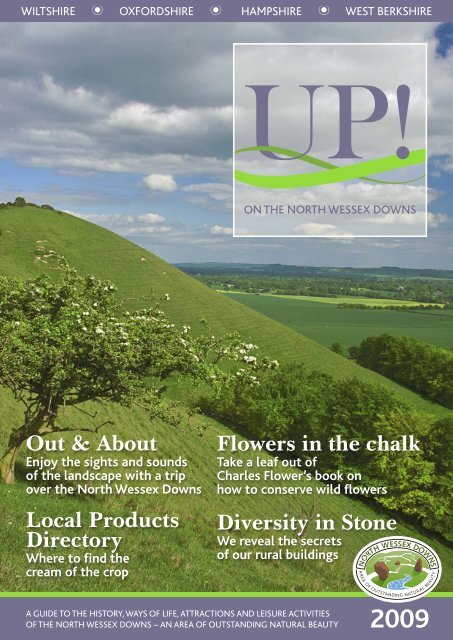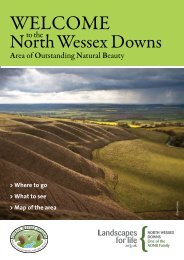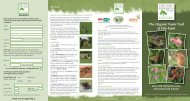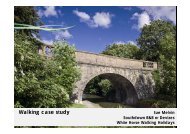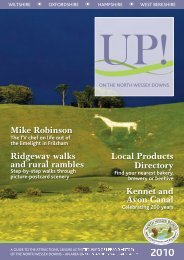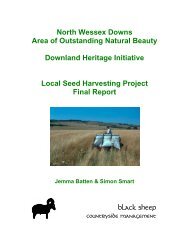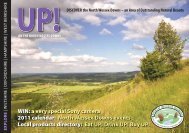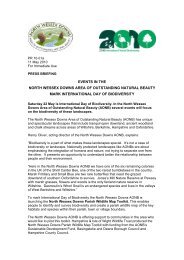UP! In the North Wessex Downs 2009 - North Wessex Downs Area ...
UP! In the North Wessex Downs 2009 - North Wessex Downs Area ...
UP! In the North Wessex Downs 2009 - North Wessex Downs Area ...
- No tags were found...
Create successful ePaper yourself
Turn your PDF publications into a flip-book with our unique Google optimized e-Paper software.
Alternating courses of cut sarsen and flints, ManorFarm, Ogbourne Maizey.This map shows simplified geology and distribution of typical building materials of <strong>the</strong> <strong>North</strong> <strong>Wessex</strong> <strong>Downs</strong> AONB.Diversity in stone eventsLEARN ABOUT THE <strong>North</strong> <strong>Wessex</strong> <strong>Downs</strong>by joining a talk or guide to identify <strong>the</strong>local building materials and <strong>the</strong> localgeology. Various events will run throughout<strong>the</strong> year, all funded by <strong>the</strong> <strong>North</strong> <strong>Wessex</strong><strong>Downs</strong> AONB.Events for <strong>the</strong> spring kick off on 18 Marchwith a talk/exhibition on ‘Diversity in Stonein <strong>the</strong> <strong>North</strong> <strong>Wessex</strong> <strong>Downs</strong>’ presented byDenise Dane – project officer for <strong>the</strong>Oxfordshire Geology Trust – in St Mary’scombination of knapped flint and cut sarsenchequerwork with limestone window frames whileAvebury Manor stable demonstrates cut sarsenslaid in courses with shaped blocks useddecoratively around its windows.FLINTFlints that have wea<strong>the</strong>red out of <strong>the</strong> chalkcan be picked up pretty much anywhere on <strong>the</strong><strong>North</strong> <strong>Wessex</strong> <strong>Downs</strong>. Knapped and teamed withbrick or sarsen stone, expertly laid flints can forma most decorative wall surface. Craftsmen tend toChurch Hall, Silverless Street, Marlborough,SN8 1JQ from 7:30pm to 9:00pm. On 28March a Guided Geological Walk around Lockeridgeand <strong>the</strong> Overtons will be led by IsobelGeddes of <strong>the</strong> Wiltshire Geology Trust from10:30am – 12:00pm, meeting at <strong>the</strong> NationalTrust sarsen stone field at <strong>the</strong> southwest endof Lockeridge village, GR SU 147675.See www.northwessexdowns.org.uk orwww.oxfordshiregt.org for details of eventsthroughout <strong>the</strong> year.knap only <strong>the</strong> surface to be left exposed andfor good reason; <strong>the</strong> shiny surface of a knappedflint does not bond well with mortar.There’s a handsome wall built entirelyof flint, save for <strong>the</strong> brick framing, to admireat Ashmansworth. But to see an example ofsheer bravado on <strong>the</strong> part of its builder, drivea few miles north out of Marlborough toOgbourne Maizey and find Manor Farm.Its front façade comprises alternatingcourses of cut sarsen and flints and itlooks very fine indeed.BRICK AND TILEThere’s a lot to be said for brick and <strong>the</strong> <strong>North</strong><strong>Wessex</strong> <strong>Downs</strong> AONB says it all. It was <strong>the</strong> mainbuilding material in those areas underlaid byPalaeogene clays (<strong>In</strong>kpen, Hermitage and Kintbury inparticular) but elsewhere in areas where chalk, sarsenand flints were plentiful, builders combined <strong>the</strong>mwith brick thus enhancing <strong>the</strong>ir capabilities asbuilding materials.Early brick makers were on to a winner. They couldproduce an expensive building material because <strong>the</strong>yhad access to deposits of clay and – importantly –to small chalk quarries, even chalk mines, from which<strong>the</strong>y secured <strong>the</strong> chalk needed to ensure that <strong>the</strong>iron-rich clays moulded well and didn’t break up in<strong>the</strong> kiln. Different coloured bricks could be achievedby manipulating <strong>the</strong> clay/chalk mix and by varying<strong>the</strong> oxygen mix during firing, a blue-grey glazedfinish could be produced.During <strong>the</strong> 15th century, when brick makingstarted in <strong>the</strong> area, builders were restrained in <strong>the</strong>iruse, but as <strong>the</strong>y became less expensive (but stillexpensive never<strong>the</strong>less) in <strong>the</strong> 16th and 17thcenturies, <strong>the</strong>y were being used in timber-framedbuildings to replace wattle-and-daub infills, and forfireplaces, plinths, cornerstones, windows anddoor frames.At St Mary Bourne, a few miles north east ofAndover, <strong>the</strong>re is an imposing brick and flint housewhere <strong>the</strong> brick has been used for framing andstreng<strong>the</strong>ning <strong>the</strong> structure with flint beingrestricted to <strong>the</strong> wall facing. Then <strong>the</strong>re issomething equally assertive about <strong>the</strong> almshousesin Lambourn. Constructed entirely of brick, <strong>the</strong>entrance tower incorporates diamond patterns ofred and grey bricks. Ano<strong>the</strong>r example of <strong>the</strong>pleasing effect of red and grey bricks can be seenat Great Bedwyn on <strong>the</strong> Kennet and Avon Canaland yet ano<strong>the</strong>r at Chilton in Oxfordshire.Rough field flints with limestone dressings at St Mary’sChurch, Great Bedwyn.Chalk block cottage with brick and sarsen foundationsand wooden lintels at Ashbury.Brick and flint used in combination for decorativeeffect in Oxenwood.<strong>UP</strong>! ON THE NORTH WESSEX DOWNS 9
A little big shopThanks to Kennet District Council, <strong>the</strong> Village Hall Committee, a grant from <strong>the</strong> <strong>North</strong> <strong>Wessex</strong> <strong>Downs</strong>AONB and a vast amount of work, time and energy donated by an enthusiastic managementcommittee, All Cannings village now has its own shop.TED FELLOWSAbove: The All Cannings village shop.All Cannings village sits less than a mile south from<strong>the</strong> Kennet and Avon Canal, roughly four miles fromDevizes to <strong>the</strong> west and seven miles toMarlborough to <strong>the</strong> north. Not long distances, ei<strong>the</strong>r of <strong>the</strong>m,unless you want a newspaper, or a wholemeal loaf or a tin ofshoe polish. <strong>In</strong> those circumstances, even four miles seem avery long way indeed.The people of All Cannings lived without a village shop forthree years, from 2002 to 2005, for a reason that chimeswith thousands of small villages throughout <strong>the</strong> UK; whatwere once self-sufficient villages because <strong>the</strong>y had shopsenough to cater for most people’s day-to-day needs are nowjust dormitories for nearby towns. <strong>In</strong> All Cannings’ case, <strong>the</strong>last shop to go was <strong>the</strong> Post Office-cum-village shop.Fortunately All Cannings is a village with a very strongcommunity spirit, keen residents who know how to get thingsorganised and hands-on people who know how to get thingsdone. When <strong>the</strong>ir efforts come toge<strong>the</strong>r, <strong>the</strong>re’s not muchthat All Cannings cannot achieve; a village shop run by <strong>the</strong>villagers for <strong>the</strong> villagers seemed eminently achievable. And soit proved, largely thanks to a grant from <strong>the</strong> <strong>North</strong> <strong>Wessex</strong><strong>Downs</strong> AONB and o<strong>the</strong>r monetary donations, including onefrom Rural Renaissance.The All Cannings village shop opened in December 2005and it has never looked back. Shop cash sales in 2008 totalled£134,000. Not bad from a village population of about 600. Itis now in <strong>the</strong> throes of being extended to twice its originalsize. Kennet District Council has supported phase one but<strong>the</strong>re are still three fur<strong>the</strong>r phases to finance.So what process was involved in getting <strong>the</strong> shop up andrunning? A year of committee work, meetings at least once aAVEBURY’S ON THE WAYMore than £25,000 of funding, some from <strong>the</strong> <strong>North</strong> <strong>Wessex</strong> <strong>Downs</strong> AONB, has beensecured by <strong>the</strong> Avebury Community Shop Steering Group that plans to open a shop inHope Cottage on Avebury's High Street, that currently houses an Outreach Post Officeservice on four half days a week. The objective is to set up a shop that is owned andrun by and for <strong>the</strong> village. It will be both a social hub and an essential communityservice. For progress see www.aveburyshop.co.uk.EAST GARSTON GETS GOINGWith <strong>the</strong> assistance of local government funding, a grant from <strong>the</strong> <strong>North</strong> <strong>Wessex</strong><strong>Downs</strong> AONB, funding from VIRSA and donations, East Garston, in <strong>the</strong> LambournValley, has started to build its own convenience shop. The shop, which should be openby mid March, will promote <strong>the</strong> Lambourn Valley and its facilities that include walkingand riding. It will also actively encourage and promote local producers to sell <strong>the</strong>irproducts in <strong>the</strong> shop. For progress reports, see www.east-garston.com.month at which seven or eight individual committeemembers were charged with such responsibilities as applyingfor planning and building consents, applying for grants,organising fund-raising events and thinking forward aboutstaffing levels, opening times and potential suppliers.The enterprise comes across with a sense of purpose andplanning; decisions of vital importance were made by <strong>the</strong>management committee early on – for instance deciding ona Portacabin-based shop, against <strong>the</strong> attractive but muchmore expensive brick-built shop. The Portacabin would becheaper and easier to extend if need be, so that’s what nowhunkers down in <strong>the</strong> Village Hall car park; not much to look aton <strong>the</strong> outside but a great deal to look at inside – what <strong>the</strong>villagers regard as <strong>the</strong> staples of <strong>the</strong>ir lives, everything fromchocolate bars to wines, jams to washing-up liquid andbleach, bacon and eggs to postage stamps and broccolispears. “Not that different from Waitrose,” said a grinning wagwho had just come in for a packet of cigarettes, “only notquite so much stock and a smidgen less standing room!”TEAM SPIRITThe shop is run by <strong>the</strong> management committee drawn from<strong>the</strong> 160 share-holding volunteers – one £10 share only, onevote only. Rosy Lock is volunteer co-ordinator, Hilary Antrobusis responsible for green and marketing issues, two paid, parttimemanagers Sue Allsop and Alison Yeatman plusself-employed Sue Watson ensure everything runs as itshould. Hilary is also responsible for shop operations, CeliaGordon for key HR issues and keeping <strong>the</strong> photo/scrapbookup-to-date, all committee members contribute to strategyissues, Natalie Yates sees to organised events and software,Iain Shaw deals with governance and Health and Safety andJohn Mead is both secretary, fixer and doer and finance man.Anyone out <strong>the</strong>re thinking, from reading so far, that <strong>the</strong> AllCannings village shop appears to have a voracious appetitefor people’s time should take into account that it is truly a‘little big shop’. As a co-operative it has <strong>the</strong> same legal statusas <strong>the</strong> Co-op. Opening hours are 7am until 1pm, <strong>the</strong>n 3pmuntil 7pm on weekdays, 9am until 5pm on Saturdays and9am until 1pm on Sundays. Shop policy is to try to have twopeople behind <strong>the</strong> counter at any one time. Extraordinarily,not every villager uses <strong>the</strong> shop.Some still travel to one of <strong>the</strong> towns close by because, <strong>the</strong>ysay, <strong>the</strong> shop doesn’t provide all that <strong>the</strong>y need. The point of<strong>the</strong> shop isn’t only about convenience. It’s one of <strong>the</strong> hubs of<strong>the</strong> village. It will help to keep <strong>the</strong> village alive by encouragingpeople to meet, buy local and support <strong>the</strong>ir local environment.All Cannings is definitely a going concern – just like <strong>the</strong> shop.10 <strong>UP</strong>! ON THE NORTH WESSEX DOWNS
A treemendous ideaSometime in <strong>the</strong> near future, <strong>North</strong> <strong>Wessex</strong> <strong>Downs</strong>’ treeswill be made to feel very special indeed. That’s because of<strong>the</strong> Tree Council’s Tree Warden Scheme.If you like trees you’ll like <strong>the</strong> notion of <strong>the</strong>Tree Council’s Tree Warden Scheme. It is anational initiative that enables people to playan active role in conserving and enhancing <strong>the</strong>irlocal trees and woods. It was founded by <strong>the</strong> TreeCouncil and is coordinated by <strong>the</strong> Council with <strong>the</strong>support of National Grid, local communities andlocal county councils.The Tree Council launched <strong>the</strong> volunteer TreeWarden Scheme in 1990 as a national force oflocal tree champions dedicated to <strong>the</strong>ircommunities’ trees in town, city or countryside.It has coordinated <strong>the</strong> scheme nationally eversince, working with local authorities, voluntaryorganisations, parish councils and localpartnerships to set up and develop Tree Wardennetworks. Today <strong>the</strong>re are some 8,000 TreeWardens in communities throughout <strong>the</strong>UK, devoting a total of more than 1.8 millionvolunteer hours a year to <strong>the</strong> UK’s trees.JOINING THE SCHEMEA Partnership was set up by Wiltshire CountyCouncil, The Wiltshire Wildlife Trust and The TreeCouncil to look at introducing <strong>the</strong> Tree WardenScheme. The Partnership is <strong>the</strong> guidingorganisation and has involved o<strong>the</strong>r environmentalorganisations such as <strong>the</strong> Wiltshire and SwindonBiological Recording Centre (WSBRC), <strong>the</strong> ForestryCommission and <strong>the</strong> <strong>North</strong> <strong>Wessex</strong> <strong>Downs</strong> AONB.Following successful introductory events inOctober 2008 at Dinton in <strong>the</strong> south of <strong>the</strong>county and at Lockeridge in <strong>the</strong> north west, it wasclear that <strong>the</strong>re was public support for aTree Warden Scheme in Wiltshire and itwas agreed that a formal launch eventwould take place in early <strong>2009</strong>. However,in <strong>the</strong> meantime, a woodland walk wasarranged as a get-toge<strong>the</strong>r for potentialTree Wardens at Oakfrith Wood, an eventled by Wiltshire County Council CountrysideOfficer Steve Russell and attended by 40people who got to know each o<strong>the</strong>r asfellow potential Tree Wardens.FORMAL LAUNCHThe formal launch event took place at LackhamHouse on 31 January <strong>2009</strong>. Lackham Estate is setin <strong>the</strong> rural heart of Wiltshire with more than 700hectares of farmland, parkland and woodland; itoffered a magnificent venue at which to launch<strong>the</strong> scheme. The Partnership invited all interestedparties, particularly anyone who would like tobecome a Tree Warden, to come along. The eventwas a chance to sign up as one of <strong>the</strong> first newWiltshire Tree Wardens, and to enjoy somepractical taster sessions on tree identification,veteran and ancient trees in <strong>the</strong> landscape,woodland biodiversity and trees and <strong>the</strong> law.Tree Wardens in Wiltshire will be as TreeWardens elsewhere; <strong>the</strong>y will be volunteers whobelieve that trees are important in <strong>the</strong>ir local areaand are prepared to put a little time into carryingout or encouraging practical projects. The schemeis supported nationally by <strong>the</strong> Tree Council, butadministered locally by <strong>the</strong> Partnership. The projectis not looking for experts, just people wi<strong>the</strong>nthusiasm who care. It will be running aprogramme of events and training for those whohave signed up, and details of <strong>the</strong>se are availablefrom Vicky Roscoe <strong>the</strong> Tree Warden Co-ordinator.Her email address is: vickyroscoe@wiltshire.gov.ukand her telephone number is 01225 713489.The aim is to recruit a Tree Warden in everyparish, with <strong>the</strong> individual being proposed by <strong>the</strong>Parish Council, and supported by <strong>the</strong>m and by anofficer based at Wiltshire County Council. The workof a Tree Warden may include planting and caringfor trees and local woods, surveying trees andWHAT ARE TREE WARDENS?Tree Wardens are volunteers, appointedby parish councils or o<strong>the</strong>r communityorganisations. Tree wardening is a wayfor volunteers to play an active role inchampioning <strong>the</strong>ir local treescape, andto be <strong>the</strong> eyes and ears for trees in<strong>the</strong>ir communities.If you are interested in finding outabout similar schemes in your area orbecoming a Tree Warden yourself, contact<strong>the</strong> Tree Council see www.treecouncil.orgor call 020 7407 9992.ga<strong>the</strong>ring information about <strong>the</strong>m, providing earlywarning of disease or vandalism, getting toge<strong>the</strong>rwith like-minded people for training and field trips,leading guided tree walks, setting up tree nurseriesusing seeds collected locally, and above all, gettinglocal communities involved to make trees matterto everyone.The Tree Warden will be <strong>the</strong> link between <strong>the</strong>local community, <strong>the</strong> Parish Council and <strong>the</strong> newWiltshire Council thus ensuring that everyone isaware of <strong>the</strong> importance of trees and that treesare important for all kinds of reasons.HOW CAN YOU GET INVOLVED?<strong>North</strong> <strong>Wessex</strong> <strong>Downs</strong> AONB intends to roll outthis scheme across <strong>the</strong> whole area – for details call01488 685440....<strong>the</strong>y will be volunteers who believe thattrees are important in <strong>the</strong>ir local area and areprepared to put a little time into carrying outor encouraging practical projects...<strong>UP</strong>! ON THE NORTH WESSEX DOWNS 11
A climatefor changeThere’s a different air in Marlborough <strong>the</strong>se days; one ofpurpose and cautious satisfaction as <strong>the</strong> efforts of a groupcalled Marlborough Climate Pledge make a discernibledifference to <strong>the</strong> local climate.oin us, a group of local people, convincedthat if we work toge<strong>the</strong>r we will make adifference. Working toge<strong>the</strong>r as individualsand as a town, encouraging and informing eacho<strong>the</strong>r, we can make significant differences to ourenergy use.”That plea, addressed to <strong>the</strong> people ofMarlborough in Wiltshire, has resulted in <strong>the</strong>formation of Marlborough Climate Pledge (MCP)that was launched as a community initiative in2006 by former Environment Minister MichaelMeacher, in response to increasing concern aboutclimate change.MCP’s main aim as it affects <strong>the</strong> citizens ofMarlborough is to reduce <strong>the</strong>ir individual andcollective impact on climate change by promotingboth a change in <strong>the</strong>ir behaviour and culture and achange in <strong>the</strong> institutions that underpin and mouldthat culture at <strong>the</strong> local, national and internationallevel. Promoting renewable energy is a key priorityfor conserving <strong>the</strong> <strong>North</strong> <strong>Wessex</strong> <strong>Downs</strong>.Central to <strong>the</strong> project is MCP’s pledge booklet(see www.climatepledge.org.uk) with a range ofpledges in four major areas: Energy, Food, Transportand Waste. The group follows up pledgers to recordand evaluate <strong>the</strong>ir impact by calculating <strong>the</strong> CO 2 <strong>the</strong>pledgers are saving, according to estimates approvedby Defra and o<strong>the</strong>r accredited bodies.The first pledge feedback process of 100households resulted in savings of 125 tonnes (at aconservative estimate) of CO 2 , i.e. 1.25 tonnes perhousehold. This was calculated through <strong>the</strong> MCP’sown research linking local pledges to national figuresfor estimating savings.MCP organises and runs a varied programme ofpublic events designed to promote awareness andeducate, both about climate change related issuesand MCP’s pledge process. This also helpsbuild support within <strong>the</strong> pledgercommunity and to encourage fur<strong>the</strong>rparticipation as well as recruiting newpledgers and supporters.Events have included public meetingswith invited speakers to address specific issues, AlGore’s film An <strong>In</strong>convenient Truth, hosting <strong>the</strong> playBreaking <strong>the</strong> Silence (<strong>the</strong> powerful story aboutenvironmentalist Rachel Carson), organisingchildren’s ‘scrapstore’ workshops, holding ideasharingforums, a ‘solar open houses’ day, energysurveys, <strong>the</strong> Climate Day in May which sawMarlborough’s seasonal ‘human fruit and vegmachine’ humming on <strong>the</strong> High Street, and – vital to<strong>the</strong> central process – holding regular informationand pledge stalls.MCP has been instrumental in getting additionalcarbon savings from Marlborough’s mainsupermarket. After addressing a MCP meeting, <strong>the</strong>manager of Waitrose made a commitment to reduce<strong>the</strong> number of plastic carrier bags in <strong>the</strong> store.Marlborough’s Waitrose store has, since <strong>the</strong>n, made avery impressive 50% reduction, using 36,000 fewerplastic carrier bags each week, equating to around25 tonnes of CO 2 saved annually. This reduction faroutstripped <strong>the</strong> national voluntary code of practiceagreed to by Waitrose HQ.The group also highlights <strong>the</strong> importance of <strong>the</strong>political process as a crucial means of bringing aboutnecessary changes; MCP knows from Marlborough’sMP that people are being encouraged to write tohim about climate change issues and, to quote froma letter from him, he “has no doubt that this is in nosmall part due to <strong>the</strong> work MCP has done inhighlighting <strong>the</strong> issues”. MCP has encouragedparticipation in <strong>the</strong> campaign for a Climate Bill byholding letter-writing stalls and delivering aChristmas card in December 2007 (‘We're Dreamingof a White Christmas’) to <strong>the</strong> Prime Minister, withhundreds of signatures calling for a strong Bill.With support from <strong>North</strong> <strong>Wessex</strong> <strong>Downs</strong> AONB,MCP launched a Community Allotment project forthose wanting some help to get started withgrowing vegetables. The response to this reflects <strong>the</strong>national growth in enthusiasm, as more people arekeen to take control over <strong>the</strong>ir food.The community allotment has now been ‘dug anddivided’ in preparation for <strong>the</strong> growing season. Theallotmenteers are organising community tools and asecure lock-up; compost will be made and boughtand <strong>the</strong>re will be a range of composting techniquesfor <strong>the</strong> wider community to view – it is known <strong>the</strong>reis a healthy interest in worms and compost from <strong>the</strong>interest shown for <strong>the</strong> ‘Open Compost Gardens’ daythat MCP has previously organised.MCP shares <strong>the</strong> concerns highlighted by majorenvironmental organisations about <strong>the</strong> increasingthreat to food security, in part resulting from <strong>the</strong>impacts of climate change.<strong>In</strong> <strong>the</strong> autumn, MCP invited a geographicinformation expert who used data and mappingtechnology to explore <strong>the</strong> issue of climate changeand our food supply and to address <strong>the</strong> question:can existing UK farmland keep us fed, clo<strong>the</strong>d andhoused? Early next year, it plans to show <strong>the</strong> film:The Power of Community: How Cuba survived peakoil, illustrating <strong>the</strong> transition to less energyintensiveagriculture.MCP has recently taken over ‘ownership’of Marlborough’s monthly Farmers’ Market(for details of opening times see www.livingheritagesouthwest.co.uk/main/en/eveprovider-14256.html)and <strong>the</strong> AONB grant alsoprovides important development support, helpingto streng<strong>the</strong>n local food links and promote <strong>the</strong>local food economy.OTHER GREEN INITIATIVESElsewhere across <strong>the</strong> <strong>North</strong> <strong>Wessex</strong> <strong>Downs</strong>o<strong>the</strong>r projects are keeping villages green. <strong>In</strong>Blewbury, Oxfordshire, an energy initiativehas reduced domestic energy consumption(see www.blewbury.co.uk/energy fordetails); in Lambourn a community forumdiscusses ways to tackle climate change(see www.lambourn.info for details); and inHungerford <strong>the</strong> Hungerford EnvironmentalAction Group is encouraging localresidents to reduce <strong>the</strong>ir impact onclimate change with respect to lowcarbon initiatives and buying local food.
Goring and Streatley Parish Councils turned toArchimedes when <strong>the</strong>ir plan to turn <strong>the</strong> flowof <strong>the</strong> river Thames into hydro-electric powerproved too expensive and too cumbersometo achieve by more mundane means.Archimedes solves amodern problemIf you stand on <strong>the</strong> bank of <strong>the</strong> river Thames at Goring andlook at <strong>the</strong> water flowing past you are likely to think “That’s alot of water!” And <strong>the</strong>n you might start wondering what <strong>the</strong>volume of <strong>the</strong> flow could possibly be and whe<strong>the</strong>r or not it couldbe transformed into useable energy.When <strong>the</strong> Goring Parish Council (GPC) looked into <strong>the</strong> prospectof transforming <strong>the</strong> energy of <strong>the</strong> Thames into useable power itwas pleasantly surprised; an average of five million tonnes ofwater flows through <strong>the</strong> Goring Gap every day, much more afterheavy rains. Surely, <strong>the</strong> Council conjectured, that’s got to beenough to do something with?So back in 2005 <strong>the</strong> GPC decided to investigate <strong>the</strong> feasibilityof extracting hydro-electricity from <strong>the</strong> river. The idea took holdand <strong>the</strong> Council part-funded a feasibility study with SouthOxfordshire District Council. They researched specialistconsultancies, obtained three quotes and commissioned one of<strong>the</strong>m to do <strong>the</strong> groundwork. At <strong>the</strong> same time <strong>the</strong> GPC addedhydro-power to its Parish Plan – an important requirement whenseeking funding. The consultancy reported in 2006 stating that itwas possible to obtain 170kW (about enough to keep 170 homessupplied with power) from no fewer than 15 turbines at sixlocations on <strong>the</strong> weirs.<strong>In</strong> 2006 <strong>the</strong> fledgling Goring and Streatley Sustainability Group(GSSG) developed a constitution and appointed a chairman, asecretary and a treasurer, and opened a bank account all of whichproved essential when <strong>the</strong> Group started applying for grants.<strong>In</strong>dependently, Streatley had included hydro-power into its VillageStatement in <strong>the</strong> same year. Fortunately for everyone’s morale, nomember of <strong>the</strong> Group knew of <strong>the</strong> proposed scheme at Romneynear Windsor to supply <strong>the</strong> Queen in her castle; a long-runningendeavour that took 12 years to obtain all permissions and is onlynow on <strong>the</strong> verge of ordering turbines.The Feasibility Study gave everyone hope but more detailedinformation was needed. The scale of <strong>the</strong> engineering worksrequired to install 15 turbines was such that an alternative solutionhad to be found. Their search took <strong>the</strong>m back about 2,050 years to<strong>the</strong> invention of <strong>the</strong> Archimedes screw, a solution suggested by <strong>the</strong>Environment Agency (EA). The Agency recommended <strong>the</strong>installation of fish-and-eel-friendly Archimedes spirals, so <strong>the</strong>switch was made to this ancient-and-modern technology.The UK’s leading expert, Dave Mann ofMannpower, produced an outline design study whichindicated that 246kW of electrical power could beproduced from three 3.5m diameter reverseArchimedes spirals in one location. Added benefits of<strong>the</strong> scheme include zero pollution, reduction ofmore than 500 tonnes of CO 2 a year and anexpected lifetime of three generations.To fund this study GSSG has successfully appliedfor grants from Chilterns Sustainable DevelopmentFund (SDF), <strong>North</strong> <strong>Wessex</strong> <strong>Downs</strong> SDF, StreatleyPC and SODC. This phase was completed in March2008. The quest for cash continues. The process isnow part way through <strong>the</strong> Environment Survey – for which <strong>the</strong>yhad to obtain fur<strong>the</strong>r funds – with <strong>the</strong> EA funding <strong>the</strong> baselineflood risk analysis.More grants are needed to complete <strong>the</strong>se so that <strong>the</strong> necessarypermissions and licences can be obtained from <strong>the</strong> EA to allowinstallation of <strong>the</strong> spirals. To finance <strong>the</strong> actual construction, localcommunities have been sounded out regarding a local share issueand <strong>the</strong> response has been encouraging, but significant funds from<strong>the</strong> EU will also be needed to make it all happen. John Howell MPand James Elles Euro MP have already visited Goring Gap to see for<strong>the</strong>mselves what is entailed in this ambitious development. Theyare both very supportive and have offered invaluable advice onwhere to find EU funding.It’s a long road <strong>the</strong> GPC still has to travel and much of it isstrewn with fund raising to pay for <strong>the</strong> various studies and analyses.It will be a great educational destination that will increase tourismto Goring by river, coach and train. The GPC has been approachedby about nine o<strong>the</strong>r communities in a similar situation to Goringalready, so Archimedes may soon become a familiar name toschool children that live close to UK’s major rivers.GENEROUS CONTRIBUTIONSThis project would not have made any progress without <strong>the</strong>generous contributions from <strong>the</strong> following organisations: <strong>North</strong><strong>Wessex</strong> <strong>Downs</strong> AONB SDF, Chilterns AONB SDF, GSSG voluntaryfund raising activities, Streatley Parish Council, South Oxon DistrictCouncil, Goring Parish Council, Goring Amenity Association.Top left: The weirs atGoring and Streatley, 2008.Top right: Weir with three3.5m Archimedes spirals.Above: The Archimedesspiral is <strong>the</strong> preferredtechnology. It allows fishand eels to pass throughwithout harm, is low maintenance,relatively easy toinstall, visually entrancingand audibly relaxing.FURTHERINFORMATIONFor up-to-datedetails on <strong>the</strong>scheme, seewww.gssg.org.uk<strong>UP</strong>! ON THE NORTH WESSEX DOWNS 13
Once threatened, buzzards havea remarkable comeback story,and are enjoying life in <strong>the</strong> skiesabove <strong>the</strong> <strong>North</strong> <strong>Wessex</strong> <strong>Downs</strong>.The chances of seeing a buzzard are muchmore likely now than <strong>the</strong>y were 50, or evenjust ten, years ago. The buzzard is a keyexample of how in a relatively short time a speciescan re-establish itself with <strong>the</strong> ability to recoloniselost territory.Recognisable by its mewing cat-like calls whilesoaring overhead in wide, wavering, rising slowcircles, or perched motionless on telegraph poles,fence posts or dead branches, watching out for anyyoung rabbit, rat or mouse that chances to passbeneath it, <strong>the</strong>re are signs that this once rarely-seenbroad-winged hawk is once again becoming morecommon in <strong>the</strong> skies over Britain and especially soover <strong>the</strong> <strong>North</strong> <strong>Wessex</strong> <strong>Downs</strong>. The habitat here isparticularly suited to buzzards, with its open countryfor hunting, and woodland for nesting. Theundulating hilly ground in <strong>the</strong> area also helpsgenerate varied winds and rising air currents thatallow <strong>the</strong>m to take full advantage of <strong>the</strong>ir skills in<strong>the</strong> air.Buzzards are stocky birds of prey – <strong>the</strong>ir wingspancan be more than one metre, while <strong>the</strong>ir body isabout half a metre in size. Their plumage varies froma rich brown to a pale grey, with lighter markingsbeneath, giving it excellent camouflage. <strong>In</strong> flight <strong>the</strong>wing tip fea<strong>the</strong>rs spread into ‘fingers’ and have aragged, moth-like appearance. They have yellow,unfea<strong>the</strong>red legs and a brownish hooked beak.DARIN SMITHThe rise of<strong>the</strong> buzzardThey find roughly ten percent of <strong>the</strong>ir bodyweight in food daily – mostly carrion, road kill(especially in <strong>the</strong> winter), small mammals such asrabbits, large earthworms, beetles, and large insects.Buzzards hunt and forage in a variety of ways, ei<strong>the</strong>rsoaring high above with <strong>the</strong>ir wings held in a shallow‘V’ shape looking for movement on <strong>the</strong> groundbelow or watching for small mammals from a postfor hours at a time, or walking on <strong>the</strong> ground lookingfor worms.spot <strong>the</strong>m on <strong>the</strong>ir untidy raggedy nests made fromsticks. They breed early in <strong>the</strong> year so that by <strong>the</strong>time <strong>the</strong>ir chicks hatch and are demanding meat,young rabbits are out and about for food – usuallyin May.But <strong>the</strong>y haven’t always been this widespread andeasy to see. <strong>In</strong> Britain’s early pre-history <strong>the</strong> buzzardwas common. It was at its strongest while feudalBritain was undergoing an agricultural revolution,because forests were being fragmented into smallAs raptors are towards <strong>the</strong> top of <strong>the</strong> food chain,if <strong>the</strong>ir populations are healthy it implies o<strong>the</strong>rlower levels of <strong>the</strong> food chain are plentiful.When <strong>the</strong>re are problems in <strong>the</strong> environmentit will show in <strong>the</strong> raptor populations...They are relatively social birds – nestlings of oneyear stay toge<strong>the</strong>r. But <strong>the</strong> reason <strong>the</strong>y are morevisible than many o<strong>the</strong>r raptors is because <strong>the</strong>y arehighly territorial.<strong>In</strong> <strong>the</strong> UK <strong>the</strong>y are sedentary and will defend aformal territory, within which <strong>the</strong>y will probably havea number of nests. Disputes usually take place in <strong>the</strong>air, with <strong>the</strong> birds circling each o<strong>the</strong>r and calling. <strong>In</strong><strong>the</strong> spring <strong>the</strong>se aerial dog-fights and calling aremore likely to be courtships with mutual soaring,swooping and diving.Buzzards form long-lasting pairs, and traditionallylay <strong>the</strong>ir eggs and hatch <strong>the</strong>m in April, although thisappears to be getting earlier with climate change.Some are now nest building in early March, andlaying at <strong>the</strong> end of March. As this is taking placebefore <strong>the</strong> leaves come out on <strong>the</strong> trees, it is easy tocopses as <strong>the</strong> need for land, building supplies andfuel increased. The fields and enclosures encouragedrabbits to flourish, and by 1544 buzzards wereregarded as being ‘everywhere’. They were eveneaten and used in medicine.CHANGE IN FORTUNESLike most raptors in <strong>the</strong> UK, <strong>the</strong> buzzard’s change infortunes came in <strong>the</strong> 1800s. Country estates beganto exploit <strong>the</strong> profit and sport derived from gamebirds and with <strong>the</strong> development of better guns,gamekeepers were able to keep all predators awayfrom <strong>the</strong> game in a more effective way. Thispersecution caused <strong>the</strong>ir numbers to fall.Their numbers fell again throughout <strong>the</strong> 1950sand 1960s as DDT and o<strong>the</strong>r pesticides that werebeing used on farmland, travelled up through <strong>the</strong>14 <strong>UP</strong>! ON THE NORTH WESSEX DOWNS
DARIN SMITHAbove: Skylark.The farmlandbirds projectfood chain and affected <strong>the</strong>ir eggshells (bymaking <strong>the</strong>m thin and fragile), as well as making<strong>the</strong>m infertile.To fur<strong>the</strong>r decimate <strong>the</strong>ir numbers, Myxomatosiswiped out 95 percent of <strong>the</strong>ir chief food source,rabbits, within two years (1953-1955). Sodependent were buzzards on rabbits for food that<strong>the</strong>re was an almost immediate drop in buzzardnumbers by up to 50 percent.The first glimmer of hope for all of Britain’sraptors came in 1966 when some pesticides werebanned and later on, in 1984, DDT was banned too.This action relieved <strong>the</strong> strong pressures that existedlower down <strong>the</strong> food chain and enabled food websthat supported more top predators to become reestablished.Fur<strong>the</strong>r legal protection for many speciescame in 1981 with <strong>the</strong> Wildlife and Countryside Actand buzzards were placed on <strong>the</strong> list of protectedbirds. Rabbit numbers started to increase too, sobuzzards’ recovery could begin in earnest. Now <strong>the</strong>reare an estimated 50,000 pairs in Britain.As raptors are towards <strong>the</strong> top of <strong>the</strong> food chain,if <strong>the</strong>ir populations are healthy <strong>the</strong>n it implies o<strong>the</strong>rlower levels of <strong>the</strong> food chain are plentiful. When<strong>the</strong>re are problems in <strong>the</strong> environment it will showin <strong>the</strong> raptor populations.NEW LIFE FOR CHALKGRASSLANDS PROJECTThe Wiltshire Wildlife Trust’s New Life for ChalkGrasslands Project is helping <strong>the</strong> buzzards to recoverfur<strong>the</strong>r. About 80 percent of <strong>the</strong> world’s chalkgrassland is in <strong>the</strong> UK, and half of this is in Wiltshire,making it an incredibly important resource on <strong>the</strong>global scale. Ca<strong>the</strong>rine Hosie, <strong>the</strong> project managersays: “Chalk grassland is a very diverse habitat whichcan support up to 200 plants and thousands ofinvertebrates on a single site.” But one of <strong>the</strong>difficulties of maintaining <strong>the</strong> landscape’s stunningsummer beauty and sheer diversity of species is thatfewer landowners now keep any livestock of <strong>the</strong>irown so that downland sites are frequently neglected,and <strong>the</strong> lack of grazing allows <strong>the</strong>m to becomeovergrown with scrub. The project aims to changethat by conserving and restoring this nationallyimportant UK Biodiversity Action Plan (BAP) habitatby knitting toge<strong>the</strong>r downlands, coombes and valleysstretching from <strong>the</strong> <strong>North</strong> <strong>Wessex</strong> <strong>Downs</strong> through<strong>the</strong> Salisbury Plain to <strong>the</strong> Cranborne Chase and WestWiltshire <strong>Downs</strong>.PROJECT RESERVESTrust reserves that will be incorporated into <strong>the</strong>project within <strong>the</strong> <strong>North</strong> <strong>Wessex</strong> <strong>Downs</strong> AONBinclude Morgan’s Hill, Ham Hill and High ClearDown. One huge element of <strong>the</strong> project will be towork with Trust partners such as Natural England,<strong>the</strong> AONBs, RSPB, and Plantlife to name a few, tohelp wildlife on a wider scale withstand climatechange. One aim of <strong>the</strong> project will be to identifyareas between downland sites that could bereseeded with downland species, <strong>the</strong>reby starting<strong>the</strong> whole process of linking isolated areas.DARIN SMITHThe South West Farmland Birds<strong>In</strong>itiative is a partnership project tohelp farmland birds. It currently coverstwo areas, <strong>the</strong> <strong>North</strong> <strong>Wessex</strong> <strong>Downs</strong>and <strong>the</strong> Cotswolds.Sarah Dullage ofRSPB (right) tells us:“For me nothingheralds <strong>the</strong> arrival ofspring quite like <strong>the</strong>skylark’s song overhead,or <strong>the</strong> soaringdance of <strong>the</strong> lapwing,but for <strong>the</strong> past 30years farmland birds have been decliningsteadily. Here in <strong>the</strong> South West we havenationally important populations of someof our most threatened farmland species,including lapwing, grey partridge, cornbunting, tree sparrow, turtle dove andyellow wagtail. We want to help thosepopulations to thrive and grow.”Sarah tells us: “There will be a series ofevents throughout <strong>the</strong> project areas,covering what <strong>the</strong> birds need and how toprovide it. We’ll also be working with localfarmers and advisors to help <strong>the</strong>m get <strong>the</strong>best out of Environmental Stewardship. Byworking toge<strong>the</strong>r we can provide a rangeof habitats for our farmland birds to nestand feed in, giving <strong>the</strong>m a helping hand.”For more details contact Sarah Dullage,on 01380 737008 or 07818 807480 oremail her at sarah.dullage@rspb.org.uk.The South West Farmland Birds <strong>In</strong>itiativeis a partnership project between NaturalEngland, Defra, RSPB, FWAG, <strong>the</strong> CotswoldsAONB, <strong>North</strong> <strong>Wessex</strong> <strong>Downs</strong> AONB,Cranborne Chase AONB and West Wiltshire<strong>Downs</strong> and Dorset <strong>Downs</strong> AONBs, withsupport from GWCT, National Trust,Plantlife, NFU and <strong>the</strong> MOD.PETE BLYTH<strong>UP</strong>! ON THE NORTH WESSEX DOWNS 15
Setting highstandardsMany producers workingwithin <strong>the</strong> <strong>North</strong> <strong>Wessex</strong><strong>Downs</strong> AONB pride <strong>the</strong>mselves on<strong>the</strong> quality of <strong>the</strong>ir produce and<strong>the</strong>ir concern for <strong>the</strong> environmentin which <strong>the</strong>y operate.They realise that <strong>the</strong>ir type ofwork, <strong>the</strong> way <strong>the</strong>y operate and<strong>the</strong> careful management of <strong>the</strong>irlocal environment are cruciallylinked with <strong>the</strong> ongoing wellbeingof <strong>the</strong> <strong>North</strong> <strong>Wessex</strong><strong>Downs</strong> and <strong>the</strong> future successof <strong>the</strong>ir businesses.Many have joined assuranceschemes, <strong>the</strong>se are highlighted inour list as “Env-Links”.KeyWFCP: Whole FarmConservation Plan:Dedicated, tailor-mademanagement plan forall aspects of a farm,dependant on its farmtype, location andhabitat, wildlife value.Bio: Biodiversity ActionPlan: <strong>In</strong>dividuallytailored managementplan for selectedhabitats and species.WMP: WoodlandManagement Plan:Provides tailoredmanagement advicefor a particularwoodland or complexof woodlands.Org: Organic Schemes:Mainly addresschemical inputs –fertiliser, pesticideuse in crops andveterinary medicinesin livestock production.FAS: Farm AssuranceScheme: Voluntaryschemes establishingproduction standardscovering food safety,environmentalprotection, animalwelfare, and o<strong>the</strong>rimportant consumerissues. Eg. British Farmstandard with redtractor logo.Demeter: Certifiedfood comes withbiodynamic farmingwhich is ecological andholistic. It takesaccount of <strong>the</strong> soil,plants and animals, and<strong>the</strong> influence of <strong>the</strong>moon and stars.CSA: CountrysideStewardshipAgreement: ThroughCSA schemes <strong>the</strong>government makespayment to farmersand land managersto enhance andconserve landscapes,wildlife, history andhelp people enjoy<strong>the</strong>m.LEAF: LinkingEnvironment AndFarming: Promotesefficiency, transparencyand standardsthroughout <strong>the</strong> foodand farming industry.LEAF marque farmersfollow integratedfarm managementprinciples.FSC: ForestryStewardship Council:<strong>In</strong>ternational,non-governmentalorganisation promotingresponsiblemanagement of<strong>the</strong> world’s forests.Uses certificationand product labellingwith its tree-tick logo.Criteria for directoryinclusion: Productionsite must be located,or product must begrown, reared orharvested within <strong>the</strong><strong>North</strong> <strong>Wessex</strong> <strong>Downs</strong>AONB or within fivemiles of its boundary.Product must beavailable locally.All information hasbeen provided by <strong>the</strong>producers and nei<strong>the</strong>r<strong>the</strong> publishers nor<strong>North</strong> <strong>Wessex</strong> <strong>Downs</strong>AONB accept anyresponsibility for anyerrors or ommissions.Farm, Axford, Marlborough SN8 2HAT: 01672 541407/07843 289527E: dgolding@ramsburyestates.comwww.ramsburybrewery.comEnv-links: CSA, FAS, FSC, WFCP, WMP.Products: Founded 2004, based informer farm building at Stock CloseFarm, near Axford. Own brewingrecipes use Ramsbury-grown opticbarley and water from estate.Cask beers: Ramsbury Bitter, Gold,Flintknapper, Kennet Valley,Deerhunter, 506.Bottled: Gold, Flintknapper, 506.On site sales Monday-Friday, 9am-4.30pm. Phone for appointment first.O<strong>the</strong>r outlets: Website sales; pubsand clubs in 35 mile radius ofbrewery; local shops (bottled beers);local food festivals at Marlborough,Ramsbury and Aldbourne.WADWORTH & CO. LTD.Contact: Jonathan Pollock, <strong>North</strong>gateBrewery, Devizes SN10 1JWT: 01380 723361E: jonathanpollock@wadworth.co.ukwww.wadworth.co.ukProducts: Brewer, wholesaler andpub retailer. Family-business foundedin 1875. Owns nearly 260 pubs.Best-known for Wadworth 6X caskale which is distributed nationally.Weekday deliveries daily of ourproducts by Shire Horses in Devizes.Stables open to <strong>the</strong> public 1.30pmto 3.30pm Monday to Thursday.A master cooper making andrepairing wooden beer casks. VisitorCentre – discover <strong>the</strong> history andheritage of Wadworth brewing, andunderstand what makes this local,family-owned brewery so unique inan ever-changing industry.WEST BERKS BREWERYContact: Mrs Helen MaggsThe Old Bakery, Yattendon,nr Thatcham RG18 0UET: 01635 202968E: info@wbbrew.co.ukwww.wbbrew.comProducts: Micro-brewery establishedin 1995 and celebrating 14 years ofbrewing award-winning real ales,notably Good Old Boy, Maggs’Magnificent Mild, Mr Chubb'sLunchtime Bitter. Polypins for partiesand events to order. Bottled beersavailable. Brewery tours byarrangement. Shop open Monday toFriday 9am to 4pm, Saturday.10am-1pm, or by appointment.O<strong>the</strong>r outlets: Owns The Rising Sun,Stockcross, nr Newbury. Supplies pubsin Berks, Hants, Oxon, Wilts, Glos.BREAD, CAKES &FLOURDOVES FARM FOODSContact: Clare Marriage, SalisburyRd, Hungerford RG17 0RFT: 01488 684880E: mail@dovesfarm.co.ukwww.dovesfarm.co.ukEnv-links: Bio, CSA, FAS, Org, WFCP.Products: Specialist flour miller andbaker est. 1978. Range consists ofover 20 flours (including organic andwheat/gluten free), cake/bread mixes,breakfast cereals and pasta. Bakeryproduces Fairtrade, organic andwheat/gluten free cookies, plus cerealbars and flapjacks. Soil Associationcertified, BRC certified, VegetarianSoc., Fairtrade Foundation, Vegan Soc.,Coeliac Soc., Slow Food member.O<strong>the</strong>r outlets: <strong>In</strong>dependents, naturalfood and multiple retailers.LACOCK BAKERYContact: Jean Sheard, 8 Church Street,Lacock, Chippenham SN15 2LBT: 01249 730457E: jean@lacock.comProducts: <strong>In</strong> National Trust village.Bread, cakes, baked on premises,bread made without improvers orpreservatives, low in salt. Specialitybreads, bread pudding, carrot cakeand Lacock Lardies. Also Marshfieldice cream, Cottage Delight preserves,old-fashioned sweets.Opening times: Open all week,10am to 5pm. Winter opening: fromstart of Nov until 28 Feb 10am to4.30pm. Baking: Monday, Wednesday,Friday, and three Saturdays a month.MAPLEDURHAM WATERMILLContact: Lola Andrews,The Estate Office, Mapledurham,nr Reading RG4 7TRT: 0118 972 3350E: enquiries@mapledurham.co.ukwww.mapledurham.co.ukEnv-links: FAS, LEAF, WFCP, WMP.Products: Wholemeal flour from lastworking watermill on Thames,available for visitors or by order fromEstate Office. Open Easter to endSept: Sat, Sun & Bank Hols 2 to 5pm.THE OLDFARMHOUSE BAKERYContact: Rodney, Kate or BeccieBitmead, By The Meadow Farm,Steventon OX13 6RPT: 01235 831230E: oldfarmhousebakery@by<strong>the</strong>meadowfarm.co.ukwww.<strong>the</strong>oldfarmhousebakery.co.ukVisit www.northwessexdowns.org.uk/products<strong>UP</strong>! ON THE NORTH WESSEX DOWNS 17
Products: A Rick Stein Food Heroand artisan bakery producing <strong>the</strong>most wonderful traditional breads –crusty oval tops, cottage loaves,spelt, stoneground organicwholemeal; speciality breads –cheese and onion plaits, leven, 100%rye; and, if you’ve a sweet tooth, tryour lardy cakes or chelsea buns!Opening times: Wednesday, Thur, Fri9am to 5pm; Sat 8.30am to 1pm.O<strong>the</strong>r outlets: Farmers Markets -Abingdon, Didcot, Hungerford,Newbury, Reading and Woodley.FRUITBOURNE VALLEYPICK-YOUR-OWNContact: Daniel Culley, Lone BarnFarm, St Mary Bourne,nr Andover SP11 6AJT: 01264 738888E: enquiries@bournevalleypyo.co.ukwww.bournevalleypyo.co.ukEnv-links: FAS.Products: Grows and sells soft fruit,strawberries, raspberries andvegetables, such as asparagus,potatoes, beans and carrots.Opening times: May-Sept: Mon-Fri8.30am-7pm, weekends 9am-5pm.CROSS LANES FRUIT FARMContact: Gillian Franklin,Mapledurham, nr Reading RG4 7UWT: 0118 972 3167E: apples@crosslanesfruitfarm.co.ukwww.crosslanesfruitfarm.co.ukProducts: Family-run fruit farmgrowing 60 varieties of traditionalEnglish apples, plums and pears.Freshly-pressed apple juices andhoney. Special Christmas boxes.Opening times: Seasonal, endAugust to mid-Jan Wednesday toSaturday 10am-6pm.O<strong>the</strong>r outlets: Various Farmers’Markets including Reading, Abingdon,Newbury, Wallingford; and Oxford.Mail order for UK; internet.HILDRED’SContact: George Hildred, SpringLeys, Wallingford Road, Goring onThames, Reading, RG8 0HPT: 01491 874471E: georgehildred@hotmail.comProducts: Pick your own asparagus,rhubarb, strawberries, raspberries,gooseberries, red and blackcurrants.Gladioli, when in season.MEAT & FISHBROOKLEAS FISH FARMContact: Tim Lobb, Brookleas, EastHendred, nr Wantage OX12 8LNT: 01235 820500E: brookleas@hotmail.comwww.brookleas.co.ukProducts: Trout farm fed by GingeBrook from local <strong>Downs</strong>. Smallfarmshop and smokery. Children’sfishing pond. Fly-fishing and livetrout restocking available on request.Member of British Trout Association.Opening times: Monday to Friday,10am to 5pm.O<strong>the</strong>r outlets: Farm shop and attends13 local Farmers’ Markets during year.CASEY FIELDS FARM SHOP(VICARS GAME)Contact: Alan or Owen Hayward,Casey Fields Farm, off Dog Lane,Ashampstead RG8 8SJT: 01635 579662E: alan@vicarsgame.co.ukwww.vicarsgame.co.ukProducts: Farm shop and butcheryselling high quality local meat atBROOKLEAS FISH FARMwholesale prices. Beef, pork, lamb,wild boar, venison, poultry, game andexotics (kudu, bison, ostrich,crocodile). Homemade sausages,burgers and bacon. Own-brandsmoked meats. Free-range eggs.Fresh vegetables and salad. Bread.Opening times: Mon-Sat 8am-5pm.O<strong>the</strong>r outlets: Wholesale throughVicars Game to local and Londonrestaurants; Fortnum & Mason; o<strong>the</strong>rfood distributors.CHALLOW HILL MEATSContact: Lucy Blackwell, ChallowHill Farm, East Challow,Wantage OX12 9PDT: 01235 765792E: info@challowhillmeats.co.ukwww.challowhillmeats.co.ukEnv-links: FAS.Products: Dexter beef, seasonal lamband rare breed pork.O<strong>the</strong>r outlets: Farmers’ Markets atAbingdon, Faringdon, Wantage,Didcot, Henley, Newbury andHungerford.CHERRY ORCHARD MEATSContact: Nick Venters, CherryOrchard Cottage, East Sands,Burbage SN8 3ANT: 01672 810257/07866 452611E: nicholasventers@tiscali.co.ukProducts: Pork sausages, bacon,gammon, pork or beef freezer packs.Pig feed contains no GM ingredientsor antibiotics (growth promoters).Refrigerated home delivery servicewithin 14-mile radius.O<strong>the</strong>r outlets: Farmers’ Markets atPewsey, Marlborough; local caterers;retailers.DEWS MEADOW FARM SHOPContact: Jane and Andrew Bowler,Oxford Rd, East Hanney OX12 0HPT: 01235 868634E: bowler.jane@btinternet.comwww.dewsmeadowfarm.co.ukEnv-links: Org.Products: Traditional homeproducedpork, bacon, sausages,burgers, pork-pies, pasties andsausage rolls. Also bread, fruit andveg. Award-winning dry-cured baconand gluten-free products.Opening times: Mon-Sat 8.30am-5pm. Late night Friday 6pm.O<strong>the</strong>r outlets: 12 Farmers’ Markets.DOWN BARN FARMContact: Mrs Penny Reid, Down BarnFarm, Sparsholt Down,Wantage OX12 9XDT: 01367 820272E: pendomeffect@aol.comEnv-links: Org, WMP.Products: Organic Shorthorn beef andTamworth pork on 100-acre (42ha)farm. Horse livery and escorted rideson <strong>Downs</strong>. Providing agri-tourism viabed and breakfast/dinner for RidgewayNational Trail visitors.O<strong>the</strong>r outlets: Supermarkets;specialist rare breed butchers.EASTBROOK FARMSORGANIC MEATContact: Carolyn Curtis,Eastbrook Farm, Cues Lane,Bishopstone, Swindon SN6 8PLT: 01793 790460E: orders@helenbrowningorganics.co.ukwww.helenbrowningorganics.co.ukEnv-links: Org.Products: Award-winning organicmeat. Prepared by skilled butchers.National home delivery service.O<strong>the</strong>r outlets: Sainsbury’s and Tescounder Helen Browning brand.GREENFIELD PORKPRODUCTSContact: Martin and DawnMartindale, Sunnycliff, HighburyRoad, Anna Valley, Andover SP11 7LUT: 01264 359422E: martinanddawn@greenfield-pork.co.ukwww.greenfield-pork.co.ukProducts: Free range pork, Wiltshiredry-cured bacon and gammons. Prizewinning sausages in Great HampshireSausage & Pie Competition 2005,2006, 2007 & 2008. Hampshire LifeBest Butcher/Meat Producer 2005.Refrigerated delivery service. Hogroast hire.O<strong>the</strong>r outlets: Hampshire Farmers’Markets; local shops.HAMPSHIRE GAMEContact: Janet Lane, Pollards Farm,Clanville, Andover, SP11 9JET: 01264 730294/07719 613906www.hampshiregame.co.ukProducts: Oven-ready game. Tradingsince mid-1970s.O<strong>the</strong>r outlets: Farmers’ Markets.KILN MEADOWS FARMContact: Gordon Hedges, Cox’s Lane,Midgham, Reading RG7 5URT: 0118 971 2138E: gordon@bynghedges.plus.comProducts: Prime quality beef frompedigree Highland cattle. All beefhung on bone for three weeks tomaximise flavour and tenderness.Visit by appointment.O<strong>the</strong>r outlets: Farmers’ Marketat Newbury.Visit www.northwessexdowns.org.uk/products
LITTLE WITTENHAM BEEF& LAMBContact: Rachael Lee,2 Hill Farm Cottages,Little Wittenham OX14 4QZT: 01865 408196E: rachael.lee@homecall.co.ukwww.northmoortrust.co.ukEnv-links: Bio, CSA, FAS, WFCP, WMP.Products: Beef & Lamb born andreared on <strong>North</strong>moor Trust’sconservation farm where animalwelfare, wildlife conservation andenvironmental best practice aregiven high-priority. Full range of cutsavailable throughout <strong>the</strong> year.Mutton seasonal. Sheepskin RugsO<strong>the</strong>r outlets: Farmers’ Markets. Farmgate, farm/lambing open days, see<strong>North</strong>moor Trust website for details.Visit by appointment.FLOWER FARMS – MIKE BAILEY/STEVE WILLIAMSROYAL BERKSHIRE PORKContact: Russell Kilvington,Tamarisk, Pudding Lane,Brightwalton RG20 7BYT: 01488 638155E: info@royalberkshirepork.co.ukwww.royalberkshirepork.co.ukEnv-links: FAS.Products: Accredited RSPCA FreedomFood pig breeder retailing own-brandpork products – sausages, bacon,gammons. Russell farms 40 acres offree-range pigs and is a formerMeridian TV Young Entrepreneur of<strong>the</strong> Year in South-East.O<strong>the</strong>r outlets: Local shops;supermarkets; caterers; also Waitroseand Sainsbury’s.SANDRIDGE FARMHOUSEBACON LTDContact: Mrs R Keen, Sandridge Farm,Bromham, nr Chippenham SN15 2JLT: 01380 850304E: info@sandridgebacon.co.ukwww.sandridgebacon.co.ukProducts: Speciality hams; Wiltshirenaturally-smoked and dry-curedbacon; sausages. Home-rearedAberdeen Angus and Hereford beef.Opening times: Farm Shop openTuesday to Saturday, 10am to 5pm.O<strong>the</strong>r outlets: Farmers’ Markets atDevizes and Wanborough;independent butchers; delicatessens;caterers; farm shops.SHEEPDROVE ORGANIC FARMContact: Sales Team Warren Farm,Lambourn , RG17 7UUT: 01488 674747E: sales@sheepdrove.comwww.sheepdrove.comEnv-links: Bio, CSA, Org, WFCP, WMP.Products: Award-winning organicfarm with Eco Conference Centre.Home delivery direct from <strong>the</strong> farm,free local delivery. Producer of organicfree-range chicken, beef, lamb,mutton, and pork. Online shop andfamily butchers in Bristol and London.O<strong>the</strong>r outlets: Online shop;telephone orders; SheepdroveOrganic Farm Family Butchers atBristol and London.STARK HOUSE FARMContact: Mrs Frances Paget, StarkHouse Farm, Goose Hill, Headley,Thatcham RG19 8ART: 01635 268205E: francespaget@uk2.netEnv-links: CSA.Products: Rare-breed Saddlebackpork, bacon and sausages. Farm salesavailable, telephone first.O<strong>the</strong>r outlets: Farmers’ Markets atNewbury and Winchester.YATESBURY HOUSE FARMContact: Richard Gantlett, GRGantlett & Son, Yatesbury HouseFarm, Yatesbury, Nr Calne SN11 8YFT: 01672 539039www.yatesbury.netEnv-links: Bio, CSA, FAS, Org, WFCP.Products: Pedigree, Aberdeen Angus,Clover fed beef produced in rotationwith cereals.PLANTS & SEEDSENGLEFIELDGARDEN CENTREContact: Miss Janet Smith,The Street, Englefield, nr Theale,Reading RG7 5EST: 0118 930 4898www.englefieldgardencentre.co.ukProducts: Charity-run garden centreproviding training for people withdisabilities. Produces high qualitybedding and herbaceous plants.Opening times: Mon to Sat 9am-5pm, Sun May to June 12 to 4pm.FLOWER FARMSContact: Bob Anderson,Carvers Hill Farm, Shalbourne,Marlborough SN8 3PST: 01672 870782E: flowerfarms@btinternet.comwww.charlesflowerswildflowers.co.ukEnv-links: CSA, FAS.Products: Wild flower seed and plants.Consultancy service available.O<strong>the</strong>r outlets: Mail order, brochureavailable, or order from <strong>the</strong> website.MEADOWMAKERContact: Sue Everett, 122 DerwentRoad, Thatcham RG19 3<strong>UP</strong>T: 01635 847164E: suejeverett@hotmail.comwww.meadowmaker.me.ukProducts: Wild-harvested seed, bycontract only, for re-creating nativegrassland (lowland meadow/calcareous grassland); consultancyfor Farm Environment Plans andEnvironmental Stewardship. <strong>In</strong>st. ofEcology and Env. Management; FloraLocale’s Code of Practice forSupplying Native Flora.WANBOROUGH HERBNURSERYContact: Bob and Peter Biggs,Wanborough Herb Nursery,Callas Hill, Upper Wanborough,Swindon SN4 0DQT: 01793 790327E: wanboroughnursery@btinternet.comwww.wanboroughherbnursery.moonfruit.comProducts: A chemical free retailnursery promoting interest in herbsand <strong>the</strong>ir uses. Also unusual orforgotten plants. We can alsoundertake plant searches for thatspecial plant for your garden.Garden design/consultation as wellas maintenance is available throughPeters' Garden Design an awardwinning designer.O<strong>the</strong>r outlets: Farmers’ Markets;Summer Shows/Fetes; talks to gardenclub/societies. Food & Drink Fairs.Visit www.northwessexdowns.org.uk/products<strong>UP</strong>! ON THE NORTH WESSEX DOWNS 19
T: 01235 831247E: <strong>the</strong>oldfarmshop@aol.comProducts: Spray and chemical-freeproduce. Own fruit, vegetables, meat,cakes, bread, pies, jams. Free-rangeeggs. Local cheese, honey. Veggiebox delivery service. PYO site.Animals to feed, visits on farm(9am to 6pm).O<strong>the</strong>r outlets: Farmers’ Markets atWantage and Wallingford.Q GARDENS FARM SHOPContact: Katie Napper, Milton Hill,Steventon, Abingdon OX13 6ABT: 01235 820988E: info@qgardensfarmshop.co.ukwww.qgardensfarmshop.co.ukEnv-links: FAS.Products: Fully stocked farm shopand butchery. Q’s own beef andlamb, locally produced pork, poultryand game. Seasonal fruit andvegetables, including asparagus,cherries, strawberries, raspberries,blackberries, currants, gooseberries,plums, greengages, damsons, apples,and pears. PYO. Tea room andchildren’s play area. Veg box schemefor local primary schools.SWAN INN + ORGANICSHOP & RESTAURANTContact: Mrs Mary Harris, The Swan<strong>In</strong>n, Lower Green, <strong>In</strong>kpen RG17 9DXT: 01488 668326E: enquiries@<strong>the</strong>swaninn-organics.co.ukwww.<strong>the</strong>swaninn-organics.co.ukEnv-links: CSA, FAS, Org.Products: Village pub, hotel and shopwhich serves meals cooked usingmainly organic ingredients. All meatorganic (hung and butchered onpremises). Pub meals all week. A lacarte restaurant Wed-Sat, Sundaylunch. Shop Wed-Fri 11am to 2.30pm,weekend 11am to 3pm. Won <strong>the</strong>RSPCA Good Business Award 2007.VITALITY FARM SHOPContact: Marianne Penny,Pangbourne Road, Theale, RG7 5EAT: 0118 930 5159E: info@vitalityfarm.co.ukwww.vitalityfarm.co.ukProducts: Wide range of local produceincluding home-produced free-rangechicken, local beef, organic lamb andmutton, free-range and rare breedpork, delicatessen, award-winning localcheeses, cakes, bread, wines, beers etc.Opening times: Wed-Sat 9am-5pm.W CUMBER & SON(THEALE)/RUSHALL FARMContact: John Bishop, Rushall Farm,Scratchface Lane, Bradfield, RG7 6DLT: 0118 974 4547E: john@rushallfarm.org.ukwww.rushallfarm.org.ukEnv-links: Bio, CSA, FAS, Org, WFCP,WMP.Products: 350-hectare farm,producing organic lamb, beef.Provides educational environmentalvisits through <strong>the</strong> John Simonds Trustand Open Days, including lambing,bluebell walks and family events.O<strong>the</strong>r outlets: Farm sales; CumbersFarm Shop at Manor Farm, Mill Rd.,Marcham, near Abingdon, OxonOX13 6NZ where we sell beef, lamband pork, rose veal and mutton,sausages and bacon.WOODBOROUGHGARDEN CENTREContact: Alison Parker Nursery Farm,Woodborough, nr Pewsey SN9 5PFT: 01672 851249E: clanparker@aol.comwww.woodboroughgardencentre.co.ukEnv-links: Org.Products: PYO fruit, vegetables anddaffodils at nursery April-October.Garden centre with coffee shop.Plants, shrubs etc.Opening times: Monday to Saturday9am to 5pm; Sunday 11am-5pm.YATTENDON ESTATE LTDContact: Alastair Jeffrey, The EstateOffice, Yattendon RG18 0UYT: 01635 203905E: alastairj@yattendon.co.ukwww.yattendon.co.ukEnv-links: Bio, CSA, FAS, FSC, LEAF,WFCP, WMP.Products: The Largest selection offresh Christmas trees in <strong>the</strong> area,seasonal decorations, associated fare.The Foresters’ yard.Opening times: December 9am to6pm, o<strong>the</strong>rwise by appointment.VEGETABLESBROMHAM GROWERSContact: Ross Paget BromhamGrowers Ltd, Barley Close Farm,Bromham, Chippenham SN15 2JAT: 01380 859891E: ross.paget@bromhamgrowers.co.ukwww.bromhamgrowers.co.ukEnv-links: FAS.Products: Wholesale operationproducing freshly prepared andwhole vegetables grown mainly onfarms in Bromham. Operates six daysa week at Barley Close Farm. Producesold all over UK. All farms underAssured Produce Scheme andpackhouse SALSA approvedO<strong>the</strong>r outlets: Specialising inBunched Carrots, which can be foundin a range of high street storesincluding J.S.Sainsbury’s and Stokes’sgreengrocers. O<strong>the</strong>r produce alsogrown, graded, washed, packed anddistributed through <strong>the</strong> wholesalemarkets around <strong>the</strong> UK.High care facility preparing,shredding, dicing, fruit andvegetables for food manufacturers.MAPLELEAF WATERCRESSContact: Alison Brown, ‘Parrotts’,Greywell Road, Mapledurwell,Basingstoke RG25 2LST: 01256 464221E: mapleleafwcress@aol.comProducts: Suppliers of traditionalbunched watercress available from<strong>the</strong> site daily to trade outlets and<strong>the</strong> public.O<strong>the</strong>r outlets: Local Farmers’Markets.OGG VALLEY ORGANICSContact: Tracy Gough, 1 WestfieldFarm, Ogbourne-St-George,Marlborough SN8 1SXT: 05601 159971E: oggvalleyorganic@btconnect.comEnv-links: Bio, Org, WFCP.Products: Family-run business est.in 1999 as organic, chemical-free210-acre vegetable farm. Seasonalroot, brassica and salad vegetables.Farm sales: 9am to 5pm. Local boxedorder deliveries.O<strong>the</strong>r outlets: Farmers’ Marketat Newbury.TOLHURST ORGANICPRODUCEContact: Iain Tolhurst, West Lodge,Hardwick, Whitchurch-on-Thames,Pangbourne RG8 7RAT: 0118 984 3428E: tolhurstorganic@yahoo.co.ukwww.tolhurstorganic.co.ukEnv-links: WFCP, Bio, Org, CSA.Products: Established in 1976,growers and distributors of organicvegetables. Operate a four-sizeveggie-box delivery scheme inReading and Oxford areas. Won ‘LocalBox Scheme of <strong>the</strong> Year 2000’ awardfrom Soil Assoc. Finalists in <strong>the</strong> BBCradio 4 Food and Farming, Farmer of<strong>the</strong> year 2007.WOOD & TREESGEORGE MEDLINWOODWORKSContact: George Medlin, The MedlinWorkshop, Little Hidden Farm,Wantage Rd, Hungerford RG17 0PNT: 07881 570301/01672 811886E: georgewoodworks@onetel.netwww.georgemedlin.co.ukProducts: Bespoke furniture usinglocal AONB, British and Europeanwoods. Commissioned work:Specialises in individually designedfurniture crafted to suit all homes,styles and client requirements. Medlindesignedtraditional specimen piecesavailable. Visit by appointment only.MARNIE MOYLE & GREENOAK FURNITUREContact: Marnie Moyle,1 Catmore Road, West Ilsley RG20 7ATT: 01635 281786E: oak@twang.co.ukwww.marniemoyle.co.ukProducts: Marnie’s simple, sturdyoutdoor designs use locally harvestedunseasoned green oak, which isexpected to shrink or distort to adduniqueness and character. Each pieceis additionally carved with words ordesigns, and <strong>the</strong> site-origin of <strong>the</strong>wood used is carved on <strong>the</strong> undersideof <strong>the</strong> bespoke work. All furniture ismade to commission.STICKS & STONESContact: Garp or Liis Flack, <strong>North</strong>Lodge, Shaw Farm, Lockeridge, nrMarlborough SN8 4LUT: 01672 852268E: info@uksticksandstones.comwww.uksticksandstones.comProducts: Bespoke handmadekitchenware such as individuallydesignedchopping blocks,cheeseboards and salad bowls madefrom blocks of locally sourced timberand rock.O<strong>the</strong>r outlets: Sticks and StonesShop, 2 Thached Barn, WoodboroughGarden Centre, Woodborough, Open:Tuesday-Sunday; Marlborough HighStreet market (Weds and Sat); website.If you would like a FREE listing in our next Local Products Directory call 01488 685440 or email info@northwessexdowns.org.ukVisit www.northwessexdowns.org.uk/products<strong>UP</strong>! ON THE NORTH WESSEX DOWNS 21
NewsLeader FundingAvailableTHE NORTH WESSEX <strong>Downs</strong> Leader Action Group(LAG) was delighted to secure £2.5 million fundingfor supporting <strong>the</strong> rural economy of <strong>the</strong> areabetween <strong>2009</strong> and 2013 from <strong>the</strong> LeaderProgramme. The programme is now open andreceiving applications. If you have a project which isin need of funding, now is <strong>the</strong> time to apply. Projectswill be considered for funding if <strong>the</strong>y meet one ormore of <strong>the</strong> following criteria:1. Creating opportunities to enjoy <strong>the</strong> <strong>North</strong><strong>Wessex</strong> <strong>Downs</strong>We wish to develop and deliver a vision of <strong>the</strong><strong>North</strong> <strong>Wessex</strong> <strong>Downs</strong> as an area for green tourism,with easily accessible information about its wildlife,culture and history, and with many opportunitiesto explore, walk, cycle and ride. We also wish tobuild on <strong>the</strong> existing culture of volunteering andeducation in <strong>the</strong> area.2. Supporting community development andbusiness transformationThe <strong>North</strong> <strong>Wessex</strong> <strong>Downs</strong> contains some areas ofreal economic and social deprivation, especially interms of access to services and opportunities. Wewish to generate support in <strong>the</strong>se areas. Tourism willprovide an opportunity for economic development,but we wish to support a wider range of activities.We also wish to support activities that enable<strong>the</strong> farming and forestry sector to connect withcommunity and economic development.3. Promoting local foodFood production is key to maintaining <strong>the</strong> landscapeof <strong>the</strong> <strong>North</strong> <strong>Wessex</strong> <strong>Downs</strong>. We wish to ensure that<strong>the</strong>re is more opportunity for those living in and,more importantly, <strong>the</strong> two million people livingaround <strong>the</strong> <strong>North</strong> <strong>Wessex</strong> <strong>Downs</strong> to buy local food.To this end, we want to support <strong>the</strong> production,processing, and consumption of local food in <strong>the</strong><strong>North</strong> <strong>Wessex</strong> <strong>Downs</strong>.4. Climate change adaptation and mitigationWe strongly believe that <strong>the</strong> <strong>North</strong> <strong>Wessex</strong> <strong>Downs</strong>has a role to play in becoming a place that usesenergy carefully, produces renewable energy, andprepares for <strong>the</strong> changing climate. We will, inparticular, be encouraging activities that lead to <strong>the</strong>management of woodlands in <strong>the</strong> <strong>North</strong> <strong>Wessex</strong><strong>Downs</strong> to produce wood for woodfuel, and toencourage <strong>the</strong> uptake of <strong>the</strong> technology for <strong>the</strong> woodto be used locally to provide heating and electricity.New Management PlanA NEW MANAGEMENT Plan for <strong>the</strong> <strong>North</strong><strong>Wessex</strong> <strong>Downs</strong> AONB will be published inlate <strong>2009</strong>. The <strong>North</strong> <strong>Wessex</strong> <strong>Downs</strong>AONB Management Plan is not just for<strong>the</strong> <strong>North</strong> <strong>Wessex</strong> <strong>Downs</strong> AONB team; itguides <strong>the</strong> activity of all who live and workin <strong>the</strong> protected landscape, to helpconserve and enhance its natural beauty.The new plan builds on <strong>the</strong> previousplan. The review process, started inSupport for PartnersMany organisations andindividuals are involved inmanaging <strong>the</strong> landscape of<strong>the</strong> <strong>North</strong> <strong>Wessex</strong> <strong>Downs</strong> AONB sothat it retains its natural beauty. Manymore are involved in researching andhelping o<strong>the</strong>rs to learn about and enjoythis special landscape.The Council of Partners is <strong>the</strong> formal‘Board’ for overseeing <strong>the</strong> managementof this area. It brings toge<strong>the</strong>r all <strong>the</strong>interests in <strong>the</strong> <strong>North</strong> <strong>Wessex</strong> <strong>Downs</strong>. Itconsists of government agencies, localauthorities, land managers, localcommunities, and conservation,autumn 2007, has involved <strong>the</strong> localauthorities, community and businessorganisations, farmers, wildlife andenvironmental groups and parish councils.The draft will be available for consultationin <strong>2009</strong>. If you would like to get involvedor just to keep up-to-date with progressvisit www.northwessexdowns.org.ukor contact <strong>the</strong> <strong>North</strong> <strong>Wessex</strong> <strong>Downs</strong>AONB team.recreation and heritage interests.The <strong>North</strong> <strong>Wessex</strong> <strong>Downs</strong> AONBteam advises <strong>the</strong> Council of Partners,and implements its decisions andpolicies. It undertakes activity onbehalf of <strong>the</strong> Council of Partners toprotect and enhance <strong>the</strong> naturalbeauty of this landscape. Much of <strong>the</strong>work of <strong>the</strong> team is in collaborationwith a wide range of individuals andorganisations. Articles in this magazinehighlight several of <strong>the</strong>se projects, and<strong>the</strong> items here give a small flavour ofour work. For more information, pleasesee www.northwessexdowns.org.uk.LEADER is a European funding programme.To find out more or to apply visitwww.northwessexdowns.org.uk or contact <strong>the</strong><strong>North</strong> <strong>Wessex</strong> <strong>Downs</strong> AONB office 01488 685440.22 <strong>UP</strong>! ON THE NORTH WESSEX DOWNS
The <strong>North</strong> <strong>Wessex</strong> <strong>Downs</strong> AONB24 <strong>UP</strong>! ON THE NORTH WESSEX DOWNS


